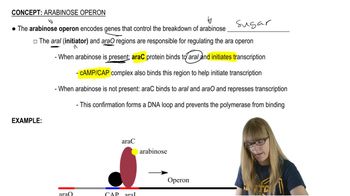Explain the circumstances under which attenuation of operon gene expression is advantageous to a bacterial organism. Would you expect attenuation to be found in a single-celled eukaryote? In a multicelled eukaryote?
Table of contents
- 1. Introduction to Genetics51m
- 2. Mendel's Laws of Inheritance3h 37m
- 3. Extensions to Mendelian Inheritance2h 41m
- 4. Genetic Mapping and Linkage2h 28m
- 5. Genetics of Bacteria and Viruses1h 21m
- 6. Chromosomal Variation1h 48m
- 7. DNA and Chromosome Structure56m
- 8. DNA Replication1h 10m
- 9. Mitosis and Meiosis1h 34m
- 10. Transcription1h 0m
- 11. Translation58m
- 12. Gene Regulation in Prokaryotes1h 19m
- 13. Gene Regulation in Eukaryotes44m
- 14. Genetic Control of Development44m
- 15. Genomes and Genomics1h 50m
- 16. Transposable Elements47m
- 17. Mutation, Repair, and Recombination1h 6m
- 18. Molecular Genetic Tools19m
- 19. Cancer Genetics29m
- 20. Quantitative Genetics1h 26m
- 21. Population Genetics50m
- 22. Evolutionary Genetics29m
12. Gene Regulation in Prokaryotes
Tryptophan Operon and Attenuation
Problem 24
Textbook Question
A repressible operon system, like the trp operon, contains three genes, G, Z, and W. Operon genes are synthesized when the end product of the operon synthesis pathway is absent, but there is no synthesis when the end product is present. One of these genes is an operator, one is a regulatory protein, and the other is a structural enzyme involved in synthesis of the end product. In the table below, '+' indicates that the enzyme is synthesized by the operon and '−' means that no enzyme synthesis occurs. Use this information to determine which gene corresponds to each operon function. <>
 Verified step by step guidance
Verified step by step guidance1
Step 1: Understand the concept of a repressible operon system. A repressible operon, such as the trp operon, is regulated by the presence or absence of the end product of its synthesis pathway. When the end product is absent, the operon is active, and the genes are transcribed to synthesize the enzyme. When the end product is present, it binds to the regulatory protein, which then inhibits transcription by interacting with the operator.
Step 2: Identify the roles of the three genes in the operon system. The operon typically consists of: (1) a structural gene that codes for the enzyme involved in the synthesis of the end product, (2) a regulatory gene that codes for the regulatory protein, and (3) an operator sequence that interacts with the regulatory protein to control transcription.
Step 3: Analyze the table provided in the problem. The table indicates whether the enzyme is synthesized ('+') or not synthesized ('−') under different conditions. Use this information to deduce the function of each gene based on its behavior in the presence or absence of the end product.
Step 4: Match the gene functions to the operon components. The structural gene will be responsible for enzyme synthesis, the regulatory gene will produce the protein that interacts with the operator, and the operator will be the sequence that controls transcription based on the regulatory protein's activity.
Step 5: Verify your reasoning by ensuring that the behavior of each gene aligns with the repressible operon model. For example, the regulatory protein should inhibit transcription when the end product is present, and the operator should respond to the regulatory protein to control enzyme synthesis.
 Verified video answer for a similar problem:
Verified video answer for a similar problem:This video solution was recommended by our tutors as helpful for the problem above
Video duration:
4mPlay a video:
Was this helpful?
Key Concepts
Here are the essential concepts you must grasp in order to answer the question correctly.
Repressible Operon
A repressible operon is a type of genetic regulatory system that is typically active and allows for the synthesis of specific proteins when the end product is absent. When the end product accumulates, it binds to a repressor protein, which then attaches to the operator region of the operon, blocking transcription and halting protein synthesis. This mechanism helps the cell conserve resources by preventing the production of unnecessary enzymes.
Recommended video:
Guided course

Arabinose Operon
Operon Structure
An operon consists of a cluster of genes under the control of a single promoter and regulatory elements, including an operator and a regulatory gene. In the context of the trp operon, the structural genes encode enzymes necessary for tryptophan synthesis, while the operator serves as a binding site for the repressor. Understanding the operon structure is crucial for determining how gene expression is regulated in response to the presence or absence of specific metabolites.
Recommended video:
Guided course

Arabinose Operon
Gene Functions in Operons
In an operon, different genes have distinct functions: the structural gene encodes the enzyme that catalyzes a reaction in the metabolic pathway, the operator controls access to the structural gene, and the regulatory gene produces a repressor protein that modulates the operon's activity. Identifying which gene corresponds to each function is essential for understanding how the operon responds to environmental changes and regulates metabolic processes efficiently.
Recommended video:
Guided course

Functional Genomics
Related Videos
Related Practice
Textbook Question
385
views


